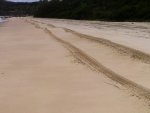Guys will air 19.5's down to whatever psi they have to, to get out of trouble. The problem with the 19.5's is the the tread ply and sidewalls are so much stronger (and puncture resistant as a result) that if they aren't reinflated after you get into trouble that running too fast for a given pressure can then generate excessive heat which can then cause tyre damage. So they can be aired right down but speed has to be monitored according to the set pressure. Granted, the speed can be much higher for an aired down XZL than a typical 19.5.
sorry john, but dont quite agree here. ive run my 11.00r16 michelins down to 10psi to get out of a mud bog. when the truck was out of the bog, the contact footprint was about 16" long.. any 19.5 rim would be well and truly on the ground by then.
also there is a lot more that comes into play with the size of the footprint, the amount of contact with the road and the "handling" of a tyre than just the psi........
definetly. IMO the biggest difference between 100R tyres and 19.5 tyres as far as road handling will be the slip angle. ie the angle of the tread/direction of vehicle travel to the angle the rims are pushing them. high sidewall michelins have a massive slip angle, due to the big soft sidewall. this (in theory) should make them more forgiving. the 19.5s will be much more solid, feel more responsive, and therortically will let go sooner (less elasticity in the tyre sidewall) BUUUT i think driving a truck on bitumen it would roll before any of this was reached.
Andrew








